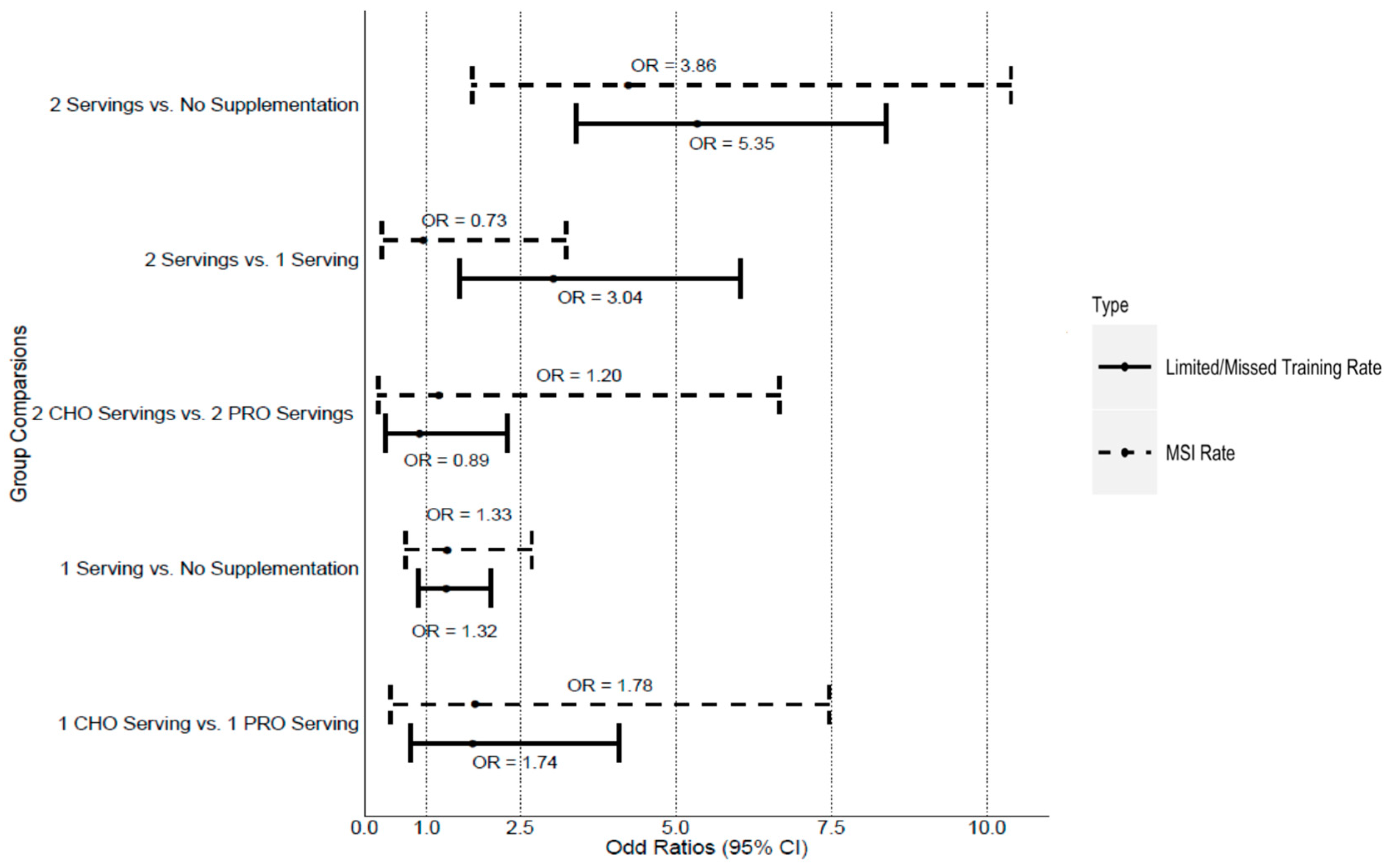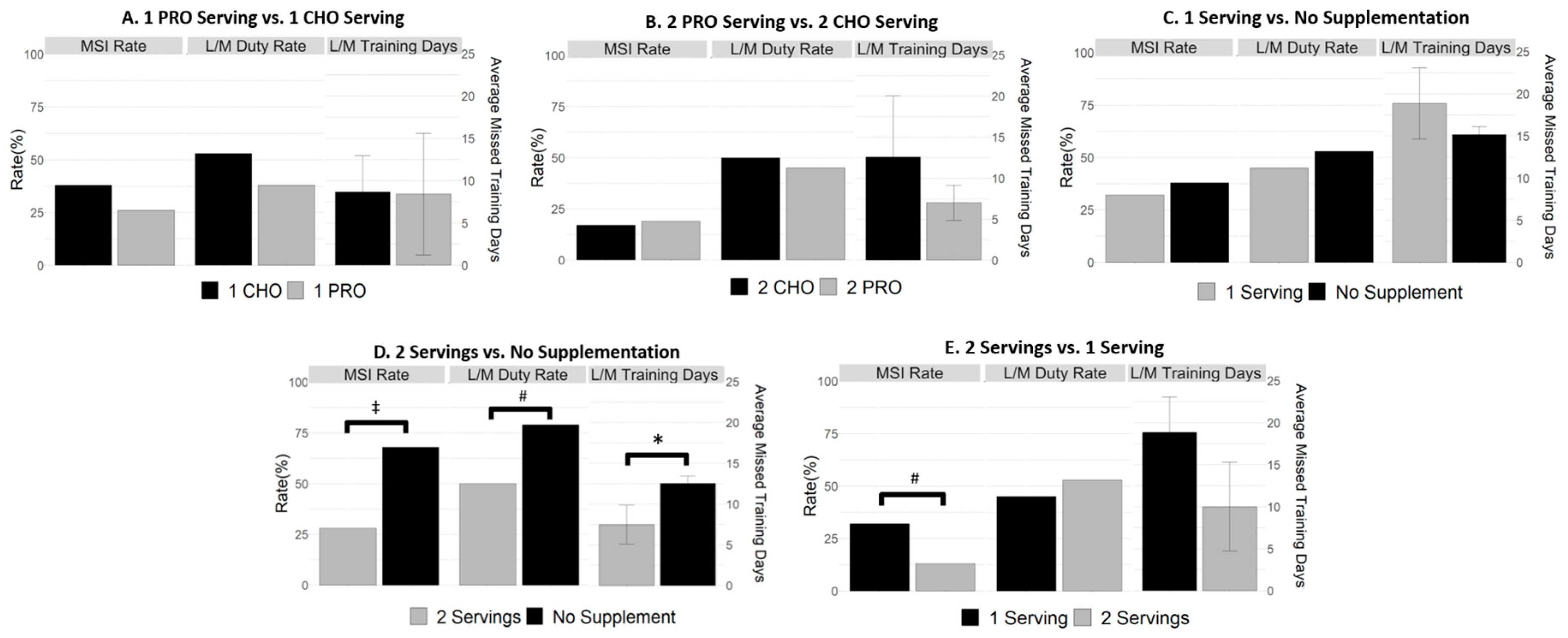Impact of Protein and Carbohydrate Supplementation on Musculoskeletal Injuries in Army Initial Entry Training Soldiers
Abstract
1. Introduction
2. Materials and Methods
Statistical Analysis
3. Results
3.1. MSI Rates
3.2. Limited/Missed Duty Rates
3.3. Limited/Missed Training Days
4. Discussion
5. Conclusions
Author Contributions
Funding
Acknowledgments
Conflicts of Interest
References
- Teyhen, D.S. Professional Soldier Athlete: The Cornerstone of Strategic Landpower’s Human Dimension; Association of the United States Army: Arlington, TX, USA, 2014. [Google Scholar]
- Army, D.O.T. Prevention and Control of Musculoskeletal Injuries Associated With Physical Training. Tech. Bull. Med. 2011, 592, 1–81. [Google Scholar]
- Simpson, K.; Redmond, J.E.; Cohen, B.S.; Hendrickson, N.R.; Spiering, B.A.; Steelman, R.; Knapik, J.J.; Sharp, M.A. Quantification of physical activity performed during US Army Basic Combat Training. US Army Med. Dep. J. 2013, 4, 55–65. [Google Scholar]
- Molloy, J.M.; Feltwell, D.N.; Scott, S.J.; Niebuhr, D.W. Physical training injuries and interventions for military recruits. Mil. Med. 2012, 177, 553–558. [Google Scholar] [CrossRef] [PubMed]
- Bulzacchelli, M.T.; Sulsky, S.I.; Rodriguez-Monguio, R.; Karlsson, L.H.; Hill, M.O.T. Injury during US Army basic combat training: A systematic review of risk factor studies. Am. J. Prev. Med. 2014, 47, 813–822. [Google Scholar] [CrossRef] [PubMed]
- Sefton, J.M.; Lohse, K.; McAdam, J. Prediction of injuries and injury types in army basic training, infantry, armor, and cavalry trainees using a common fitness screen. J. Athl. Train. 2016, 51, 849–857. [Google Scholar] [CrossRef] [PubMed]
- Nindl, B.; Friedl, K.; Frykman, P.; Marchitelli, L.; Shippee, R.; Patton, J. Physical performance and metabolic recovery among lean, healthy men following a prolonged energy deficit. Int. J. Sports Med. 1997, 18, 317–324. [Google Scholar] [CrossRef] [PubMed]
- Green, M.W.; Rogers, P.J. Impaired cognitive functioning during spontaneous dieting. Psychol. Med. 1995, 25, 1003–1010. [Google Scholar] [CrossRef] [PubMed]
- Kemps, E.; Tiggemann, M.; Marshall, K. Relationship between dieting to lose weight and the functioning of the central executive. Appetite 2005, 45, 287–294. [Google Scholar] [CrossRef]
- Moran, D.S.; Heled, Y.; Arbel, Y.; Israeli, E.; Finestone, A.S.; Evans, R.K.; Yanovich, R. Dietary intake and stress fractures among elite male combat recruits. J. Int. Soc. Sports Nutr. 2012, 9, 6. [Google Scholar] [CrossRef]
- Margolis, L.M.; Pasiakos, S.M.; Karl, J.P.; Rood, J.C.; Cable, S.J.; Williams, K.W.; Young, A.J.; McClung, J.P. Differential effects of military training on fat-free mass and plasma amino acid adaptations in men and women. Nutrients 2012, 4, 2035–2046. [Google Scholar] [CrossRef]
- McAdam, J.; McGinnis, K.; Ory, R.; Young, K.; Fruge, A.; Roberts, M.; Sefton, J.M. Estimation of energy balance and training volume during Army initial entry training. J. Int. Soc. Sports Nutr. 2018, in press. [Google Scholar] [CrossRef] [PubMed]
- Churchward-Venne, T.A.; Burd, N.A.; Mitchell, C.J.; West, D.W.; Philp, A.; Marcotte, G.R.; Baker, S.K.; Baar, K.; Phillips, S.M. Supplementation of a suboptimal protein dose with leucine or essential amino acids: Effects on myofibrillar protein synthesis at rest and following resistance exercise in men. J. Physiol. 2012, 590, 2751–2765. [Google Scholar] [CrossRef] [PubMed]
- Res, P.T.; Groen, B.; Pennings, B.; Beelen, M.; Wallis, G.A.; Gijsen, A.P.; Senden, J.M.; Van Loon, L.J. Protein ingestion before sleep improves postexercise overnight recovery. Med. Sci. Sports Exerc. 2012, 44, 1560–1569. [Google Scholar] [CrossRef] [PubMed]
- Trommelen, J.; Van Loon, L.J. Pre-sleep protein ingestion to improve the skeletal muscle adaptive response to exercise training. Nutrients 2016, 8, 763. [Google Scholar] [CrossRef] [PubMed]
- Antonio, J.; Ellerbroek, A.; Silver, T.; Orris, S.; Scheiner, M.; Gonzalez, A.; Peacock, C.A. A high protein diet (3.4 g/kg/d) combined with a heavy resistance training program improves body composition in healthy trained men and women-a follow-up investigation. J. Int. Soc. Sports Nutr. 2015, 12, 39. [Google Scholar] [CrossRef] [PubMed]
- Hoffman, J.R.; Ratamess, N.A.; Kang, J.; Falvo, M.J.; Faigenbaum, A.D. Effect of protein intake on strength, body composition and endocrine changes in strength/power athletes. J. Int. Soc. Sports Nutr. 2006, 3, 12. [Google Scholar] [CrossRef] [PubMed]
- Hansen, M.; Bangsbo, J.; Jensen, J.; Bibby, B.M.; Madsen, K. Effect of whey protein hydrolysate on performance and recovery of top-class orienteering runners. Int. J. Sport Nutr. Exerc. Metab. 2015, 25, 97–109. [Google Scholar] [CrossRef]
- Bihuniak, J.D.; Insogna, K.L. The effects of dietary protein and amino acids on skeletal metabolism. Mol. Cell Endocrinol. 2015, 410, 78–86. [Google Scholar] [CrossRef]
- Ivy, J. Glycogen resynthesis after exercise: Effect of carbohydrate intake. Int. J. Sports Med. 1998, 19, S142–S145. [Google Scholar] [CrossRef]
- Flakoll, P.J.; Judy, T.; Flinn, K.; Carr, C.; Flinn, S. Postexercise protein supplementation improves health and muscle soreness during basic military training in Marine recruits. J. Appl. Physiol. 2004, 96, 951–956. [Google Scholar] [CrossRef]
- Team, R. Core. R: A Language Environment for Statistical Computing 2015. The R Foundation for Statistical Computing: Vienna. Available online: http://www.R-project.org (accessed on 29 November 2018).
- RStudio. Rstudio: Integrated Development Environment for R 2014. Available online: https://www.rstudio.com/products/rstudio/ (accessed on 29 November 2018).
- Williamson, D.A.; Martin, P.D.; Raymond, A.H.; Most, M.M.; Alfonso, A.J.; Thomas, V.; Ryan, D.H. Changes in food intake and body weight associated with basic combat training. Mil. Med. 2002, 167, 248–253. [Google Scholar] [CrossRef] [PubMed]
- Mcmurray, R.G.; Ben-Ezra, V.; Forsythe, W.A.; Smith, A.T. Responses of endurance-trained subjects to caloric deficits induced by diet or exercise. Med. Sci. Sports Exerc. 1985, 17, 574–579. [Google Scholar] [CrossRef] [PubMed]
- Knapik, J.; Montain, S.; McGraw, S.; Grier, T.; Ely, M.; Jones, B. Stress fracture risk factors in basic combat training. Int. J. Sports Med. 2012, 33, 940–946. [Google Scholar] [CrossRef] [PubMed]
- Ihle, R.; Loucks, A.B. Dose-response relationships between energy availability and bone turnover in young exercising women. J. Bone Min. Res. 2004, 19, 1231–1240. [Google Scholar] [CrossRef] [PubMed]
- Zanker, C.L.; Swaine, I.L. Responses of bone turnover markers to repeated endurance running in humans under conditions of energy balance or energy restriction. Eur. J. Appl. Physiol. 2000, 83, 434–440. [Google Scholar] [CrossRef] [PubMed]
- Nindl, B.C.; Barnes, B.R.; Alemany, J.A.; Frykman, P.N.; Shippee, R.L.; Friedl, K.E. Physiological consequences of US Army Ranger training. Med. Sci. Sports Exerc. 2007, 39, 1380–1387. [Google Scholar] [CrossRef] [PubMed]
- Tipton, K.D.; Elliott, T.A.; Cree, M.G.; Aarsland, A.A.; Sanford, A.P.; Wolfe, R.R. Stimulation of net muscle protein synthesis by whey protein ingestion before and after exercise. Am. J. Physiol. Endocrinol. Metab. 2007, 292, E71–E76. [Google Scholar] [CrossRef]


| Group | Age (yrs) | Height (cm) | Weight (kg) |
|---|---|---|---|
| 1 WP Serving Group (n = 50) | 21.4 ± 3.2 | 172.9 ± 7.6 | 75.1 ± 13.1 |
| 1 CHO Serving Group (n = 50) | 22.8 ± 3.7 | 174.9 ± 7.7 | 78.1 ± 14.8 |
| 2 WP Serving Group (n = 56) | 18.6 ± 1.0 | 172.8 ± 6.0 | 71.7 ± 12.3 |
| 2 CHO Serving Group (n = 56) | 18.5 ± 1.2 | 172.9 ± 5.4 | 71.0 ± 11.0 |
| Historical Data (n = 1963) | NC | NC | NC |
| Group | MSI Rates | Limited/Missed Duty Rates |
|---|---|---|
| 1 WP serving (10 weeks) | 13/50 (26%) | 5/13 (38%) |
| 1 CHO serving (10 weeks) | 19/50 (38%) | 10/19 (53%) |
| 2 WP servings (15 weeks) | 11/56 (19%) | 5/11 (45%) |
| 2 CHO servings (15 weeks) | 10/56 (17%) | 5/10 (50%) |
| 2 WP or CHO servings (15 weeks) | 32/112 (28%) | 16/32 (50%) |
| No supplementation (15 weeks) | 340/499 (68%) | 270/340 (79%) |
| 2 WP or CHO servings (10 weeks) | 15/112 (13%) | 8/15 (53%) |
| 1 WP or CHO serving (10 weeks) | 32/100 (32%) | 15/33 (45%) |
| No supplementation (10 weeks) | 561/1464 (38%) | 295/561 (53%) |
© 2018 by the authors. Licensee MDPI, Basel, Switzerland. This article is an open access article distributed under the terms and conditions of the Creative Commons Attribution (CC BY) license (http://creativecommons.org/licenses/by/4.0/).
Share and Cite
McGinnis, K.D.; McAdam, J.S.; Lockwood, C.M.; Young, K.C.; Roberts, M.D.; Sefton, J.M. Impact of Protein and Carbohydrate Supplementation on Musculoskeletal Injuries in Army Initial Entry Training Soldiers. Nutrients 2018, 10, 1938. https://doi.org/10.3390/nu10121938
McGinnis KD, McAdam JS, Lockwood CM, Young KC, Roberts MD, Sefton JM. Impact of Protein and Carbohydrate Supplementation on Musculoskeletal Injuries in Army Initial Entry Training Soldiers. Nutrients. 2018; 10(12):1938. https://doi.org/10.3390/nu10121938
Chicago/Turabian StyleMcGinnis, Kaitlin D., Jeremy S. McAdam, Christopher M. Lockwood, Kaelin C. Young, Michael D. Roberts, and JoEllen M. Sefton. 2018. "Impact of Protein and Carbohydrate Supplementation on Musculoskeletal Injuries in Army Initial Entry Training Soldiers" Nutrients 10, no. 12: 1938. https://doi.org/10.3390/nu10121938
APA StyleMcGinnis, K. D., McAdam, J. S., Lockwood, C. M., Young, K. C., Roberts, M. D., & Sefton, J. M. (2018). Impact of Protein and Carbohydrate Supplementation on Musculoskeletal Injuries in Army Initial Entry Training Soldiers. Nutrients, 10(12), 1938. https://doi.org/10.3390/nu10121938






